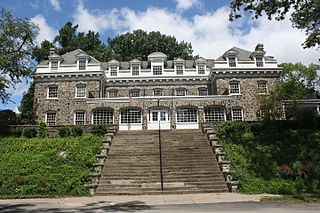
Emily Helen Butterfield was a pioneer in the Michigan women's movement.

The Thomas R. McGuire House, located at 114 Rice Street in the Capitol View Historic District of Little Rock, Arkansas, is a unique interpretation of the Colonial Revival style of architecture. Built by Thomas R. McGuire, a master machinist with the Iron Mountain and Southern Railroad, it is the finest example of the architectural style in the turn-of-the-century neighborhood. It is rendered from hand-crafted or locally manufactured materials and serves as a triumph in concrete block construction. Significant for both its architecture and engineering, the property was placed on the National Register of Historic Places on December 19, 1991.

The Phi Gamma Delta Fraternity House in Minneapolis, Minnesota is the University of Minnesota chapter house of Phi Gamma Delta. The house, located just across University Avenue from the East Bank Campus, is listed on the National Register of Historic Places for its distinctive architecture, as well as its role in the development of fraternity housing in Minnesota.

The Grove, also known as Loretto Rest, is a historic house located on Grove Court in Cold Spring, New York, United States. It was built as the estate of Frederick Lente, surgeon at the nearby West Point Foundry and later a founder of the American Academy of Medicine, in the mid-19th century. The Italian-villa design, popular at the time, was by the prominent architect Richard Upjohn. In 2008 it was listed on the National Register of Historic Places.

The Jonesborough Historic District is a historic district in Jonesborough, Tennessee, that was listed on the National Register of Historic Places as Jonesboro Historic District in 1969.

The Zeta Psi Fraternity House at Lafayette College is a historic house located on the campus of Lafayette College in Easton, Northampton County, Pennsylvania. The Tau Chapter of the Zeta Psi fraternity built the house between 1909 and 1910. It was added to the National Register of Historic Places in 2001.

Jackson Park Town Site Addition Brick Row is a group of three historic houses and two frame garages located on the west side of the 300 block of South Third Street in Lander, Wyoming. Two of the homes were built in 1917, and the third in 1919. The properties were added to the National Register of Historic Places on February 27, 2003.

The Alpha Tau Omega Fraternity House, also known as the ATO House, is a Colonial Revival building in Reno, Nevada that was built in 1929. It was listed on the National Register of Historic Places in 2004.

The Delta Kappa Epsilon Fraternity House was a historic fraternity house located at the University of Illinois at Urbana–Champaign in Champaign, Illinois. It was built in 1906 and was used by various fraternities and sororities before being demolished in 2020.

The Alpha Phi Fraternity House-Beta Alpha Chapter is a historic fraternity house located at the University of Illinois at Urbana–Champaign in Champaign, Illinois, United States. The house was added to the National Register of Historic Places on November 15, 2005.

The Alpha Gamma Delta Fraternity House is a historic fraternity house located at the University of Illinois at Urbana–Champaign in Urbana, Illinois. The house was added to the National Register of Historic Places on August 5, 2009.

Nappanee Eastside Historic District is a national historic district located at Nappanee, Elkhart County, Indiana. The district encompasses 138 contributing buildings in a predominantly residential section of Nappanee. It was developed between about 1880 and 1940, and includes notable examples of Italianate, Queen Anne, Colonial Revival, and Prairie School style architecture. Located in the district are the separately listed Frank and Katharine Coppes House and Arthur Miller House.

Alpha Tau Omega Fraternity House, also known as Maltese Manor, is a historic fraternity house located at Purdue University in West Lafayette, Indiana. It was listed on the National Register of Historic Places on March 20, 2002. In 2023, it was adapted into the Revive 314 student apartment complex.

The Edward Wells House is a historic house at 61 Summit Street in Burlington, Vermont. Built in 1891–92 for the president of a patent medicine maker, it is one of the city's finest examples of Queen Anne Victorian architecture executed in brick and stone. It was listed on the National Register of Historic Places in 1979. The house was for many years home to the Delta Psi fraternity; is now owned by the University of Vermont.

The Langdon Street Historic District is a historic neighborhood east of the UW campus in Madison, Wisconsin - home to some of Madison's most prominent residents like John B. Winslow, Chief Justice of the state Supreme Court, and nationally recognized historian Frederick Jackson Turner. The district has a high concentration of period revival style buildings - many built from 1900 to 1930 to house Greek letter societies, and many designed by Madison's prominent architects. In 1986 the district was added to the National Register of Historic Places.

The Sigma Alpha Epsilon Fraternity House is a historic fraternity house in Moscow, Idaho. It was built in 1932 for the Idaho Alpha chapter of Sigma Alpha Epsilon at the University of Idaho. The house was designed by architect Charles I. Carpenter in the Colonial Revival style. It has been listed on the National Register of Historic Places since December 31, 1993.


















